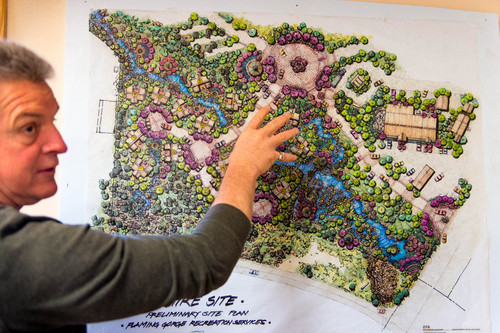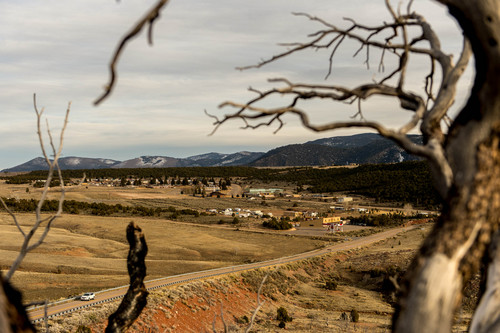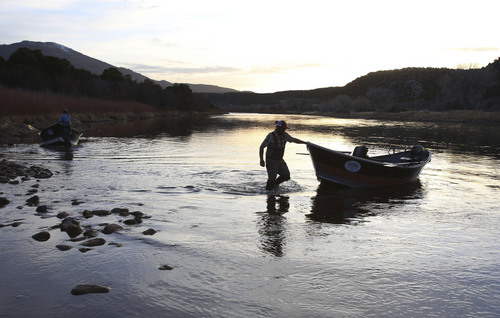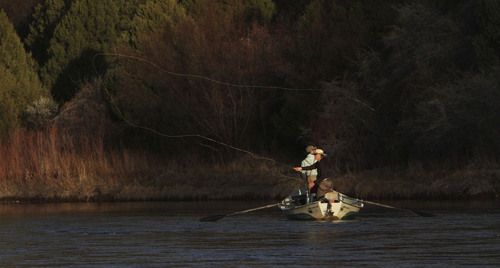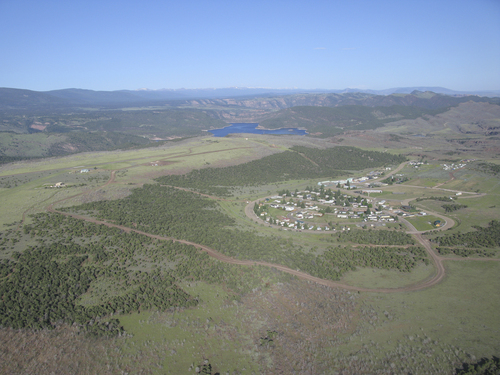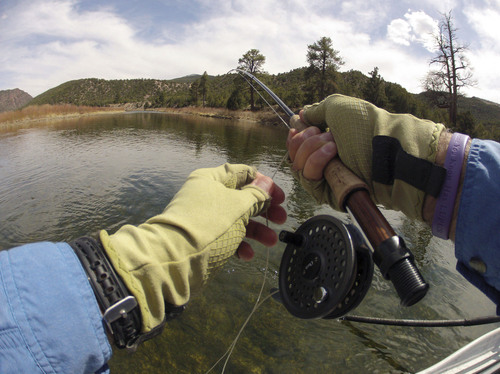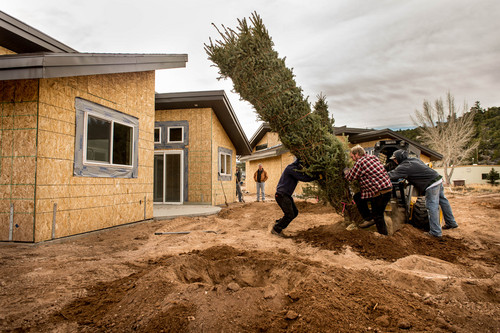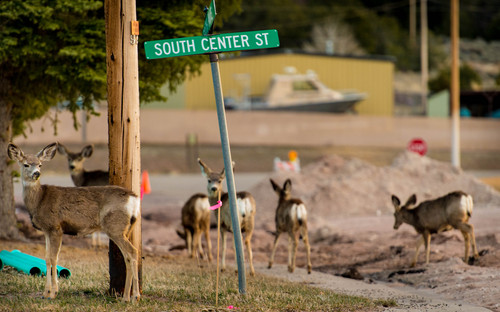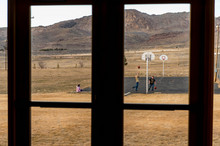This is an archived article that was published on sltrib.com in 2014, and information in the article may be outdated. It is provided only for personal research purposes and may not be reprinted.
Dutch John • This Daggett County hamlet has been misunderstood from the start.
Area residents coined the name in the 1860s because immigrant John Honselena wintered his horses on the flats where the community now sits.
Honselena, as it turns out, was German, not Dutch.
The name stuck in 1957, when Bureau of Reclamation officials began preparing to raise Flaming Gorge Dam on the Green River by building living quarters for workers on the same spot.
The dam was completed in 1964, but the community remained — albeit with fewer residents — and became a town reliant on federal support in a state wary of the national government.
But the last check arrived in February 2013. And although Dutch John was warned in 1998 to get ready, it didn't.
"From the very beginning we knew we had 15 years. That was good and bad," said John Morton, who works at the dam and has been living in Dutch John since 1991.
"We knew we had time, but it seemed like a long ways off so people didn't feel in a hurry," he said. "The people in town reacted OK and started to consider plans, but I don't think the county had the best plan."
Dutch John today is a quiet home for Bureau of Reclamation workers at the dam, U.S. Forest Service employees, Utah Division of Wildlife Resources biologists and law enforcement officers, along with fly-fishing guides.
Visitors are almost assuredly there to fly-fish on the Green River, though a growing number use Dutch John as a base for fishing trips on Flaming Gorge Reservoir.
But the community and county officials are clashing over Dutch John's future.
"This is a pretty nice spot in the world," said Dutch John resident Dave McDonald, who is leading a bid for the community to incorporate. "The end of the federal fund need not be the end of Dutch John."
From the county's standpoint, "we want Dutch John to succeed," said Brian Raymond, Daggett County's economic development director. "We have tried to do things to make it a success. Some people over there have a different definition of success."
—
The money • The government continued to own Dutch John and pay its bills for decades after the dam was built. Residents leased the homes or land they lived on, and no one pursued new development.
The federal parenting started to end in 1998 as a new law described how the community would transition to stand on its own. Utah Republican Sens. Bob Bennett and Orrin Hatch sponsored the Dutch John Federal Property Disposition and Assistance Act.
It gave 2,450 acres in and around the community to Daggett County to serve as tax base for revenue to carry Dutch John into the future.
For 15 years, the law said, the Upper Colorado River Basin Fund would send an annual payment of $300,000 (with adjustments based on the Consumer Price Index) for basic community services.
Daggett County got the first check in 1999. For years the annual contribution was used sparingly to provide basic services in Dutch John, said Morton, who helped draft the act and testified before Congress. He serves on the county's Dutch John Advisory Committee and as the community's fire chief.
The federal money was "only spent when it was absolutely necessary," Morton said. "The idea was we would build it up and have this fund at the end of 15 years, so if we didn't have a tax base, we could live off the interest."
But the fund was tapped to support the Daggett County Jail in 2008, the first time the Dutch John fund was used for something other than the community's needs, Morton said.
It opened the door for more use. After Dutch John residents voiced concern, the Bureau of Reclamation did an audit in 2011.
Daggett County was cleared to use the money for other purposes, but it was ordered to pay the bureau $350,000 for the interest the fund had improperly accrued, Morton said. The checks were supposed to be spent annually.
McDonald, who recently traveled to Washington, D.C., to speak with federal officials, said a second audit is being considered by the Office of Inspector General in the U.S. Department of the Interior.
Morton said the current balance in the account is about $400,000, down from the "$4 to $5 million" it had once been.
The county has paid for capital improvements to Dutch John's water and sewer systems. But residents say they believe the federal dollars spent elsewhere should have been repaid to the fund.
—
The land • After acquiring Dutch John, county officials began work on a development plan.
"It has been a major concern for years," Raymond said. "We have been working to build up the value and increase revenues to match, or at least offset, some of that loss. We have had some big plans. It is just taking longer than we had hoped."
Part of the problem, according to Morton, was a property-disposition ordinance that discouraged potential developers. The county has since created a rural development agency that gives it more flexibility to negotiate on projects.
McDonald wants Dutch John to incorporate, so development and other decisions can be made by a city council.
"Right now the weight of the population in Daggett County is in Manila," he said, "and a lot of decisions are pushed into Dutch John from that community."
Seventy-eight percent of the registered voters in Dutch John signed a petition to study incorporation, and the Daggett County Commission has approved hiring a Salt Lake City firm to do a feasibility study.
"People in Dutch John don't feel like they received their fair share of the millions of dollars that have come to the county," said Warren Blanchard, the first Dutch John resident to serve on the Daggett County Commission. "Everyone will admit they got some benefit, but they feel kind of like they got the short end of the stick."
Putting on his County Commission hat, Blanchard adds, "Of course, the county will say everything going to the county was to help offset the cost that Dutch John brought to the county."
Blanchard retired in 2006 after working for 10 years as the operations and dam manager at Flaming Gorge. His term ends this year, but two other Dutch John residents are running for seats.
—
The future • Ed Eudis has grand plans for Dutch John.
He and two partners bought Flaming Gorge Recreation Services in Dutch John out of bankruptcy 18 months ago. It was once the only business in town, offering two cabins, a trailer park, a garage and recreation rentals.
Trout Creek Flies eventually opened and provided similar services. The only other business in town is Sweet Lorraine's bed-and-breakfast, recently opened by McDonald.
Eudis says he's seen typical delays, but insists "commissioners have worked tirelessly to help us get things moving."
He wants to build 15 cabins of multiple sizes to appeal to a range of visitors. Some one-room cabins are already open with two-room cabins set to follow this spring and summer.
The existing store and cafe will be renovated. Eudis is leasing some of the 40-acre property from the county and has an option to buy the rest.
Crews were planting 1,132 trees last week. "We are planting more trees than there are people in Daggett County," Eudis said.
The project's sales and its new hires will boost tax revenue, he notes. His plans for elsewhere in Dutch John include remodeling the old hospital, which he has purchased from the county, into a hotel/employee housing complex and building a hotel in town.
"We have already pre-sold 900 nights. We obviously see a huge potential here," Eudis said, leading a tour of the cabins under construction. "There are two huge recreation assets here [Green River and Flaming Gorge National Recreation Area] and we see a bright future."
brettp@sltrib.com Twitter: @BrettPrettyman —
A History of Dutch John
The Bureau of Reclamation put eight transit houses and 25 trailers on a flat near the construction site for Flaming Gorge Dam in 1957.
A bunkhouse, cookhouse, mess hall, hospital and schoolhouse were also eventually added. As many as 3,500 workers lived in Dutch John at the peak of construction, which was completed in 1964.
The site was transferred to Daggett County in 1999, but the county received annual federal checks to fund public services until 2013.
Efforts to incorporate Dutch John are now being pursued and a feasibility study is underway.
Sources: "A History of Daggett County: A Modern Frontier" by Michael W. Johnson with Robert E. Parson and Daniel A. Stebbins; U.S. Department of the Interior Bureau of Reclamation.


